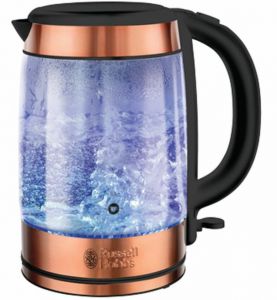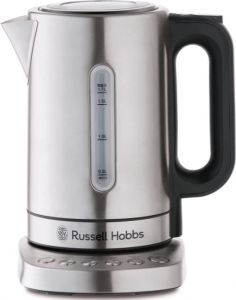Electric kettles are popular in many households because of their versatility. They’re not just designed to boil water for your tea or coffee but can also be used to make soups, heat up milk, and even boil eggs! Stainless steel kettles are the most widely used, but there are also some devilishly stylish glass kettles on the market. Which type of kettle is better? Here’s our review.
Glass kettles
Glass kettles are made from tempered glass or borosilicate glass – both of which are heat-resistant materials that can handle high temperatures of up to 170°C. Most electric kettles will only usually boil at slightly over 100°C. Tempered glass and borosilicate glass don’t rust or oxidize either.
Glass kettles are the most stylish kettles available on the market, thanks to their stylishly modern design and transparent glass body. However, they’re not as widely available as plastic or stainless steel kettles, and only select retailers stock them. Besides often taking pride of place on modern benchtops, glass kettles are also easier to keep clean than stainless steel or plastic kettles since glass isn’t sticky and tends to attract less residue.

Glass kettle pros & cons
Here are some advantages and disadvantages of glass kettles.
| Glass kettle pros | Glass kettle cons |
| Easy to check water levels through glass | Heavier than stainless steel kettles |
| Easier to clean with less limescale build-up | Prone to breaking (if dropped or knocked) |
| Sophisticated design | More expensive to buy |
Stainless steel kettles
As the name suggests, stainless steel kettles have a body (mainly the jug & handle) made of stainless steel, which is highly durable and resistant to corrosion. These are the most affordable and popular types of kettles available on the market (besides plastic kettles). You can buy them from most appliance retailers and department stores. Stainless steel kettles come in various designs, sizes, colours, and capacities to suit most households.

Stainless steel kettle pros & cons
Here are some advantages and disadvantages of stainless steel kettles.
| Stainless steel kettle pros | Stainless steel kettle cons |
| More durable (less likelihood of breaking) | Can feel hot on the exterior, even with a double-walled design |
| Steel kettles are lightweight | No transparent body to check water levels (need to open the lid each time) |
| More designs & models available | Need regular rinsing to avoid residue sitting on the bottom |
Glass vs stainless steel kettle: Which is safest?
Glass kettles can’t rust and are free from metal residue. This means they don’t have the associated problems of metallic taste, rusting, and releasing heavy metals into boiling water − many people consider them better for your health and the environment. Glass versions are also better for tea brewing and can be safely used in the microwave. On the other hand, stainless steel is still being lauded as the safest material for a kettle. Either way, make sure that any kettle you buy is free of plastic parts.
Glass vs stainless steel kettle: Which has more features?
Glass and stainless steel kettles may be different on the exterior, but share similar specs and safety features. Some to look out for include an auto-off switch, a water level indicator, a 360° swivel base, a push-button lid release, and an anti-scale filter. Most kettles also come with auto shut-off and thermal cut-off safety protection. Glass kettles also typically feature an illumination LED light.

Glass vs stainless steel kettle: Which is more durable?
Stainless steel kettles are more durable than glass kettles in the long run. This is because a) stainless steel is virtually indestructible and b) because it has a longer life cycle than glass and most other materials, especially under high or extreme temperatures. Stainless steel has superior long-life properties that don’t diminish over time or with use.
Glass vs stainless steel kettle: Which is cheaper?
Stainless kettles are much cheaper to buy than glass kettles, with prices typically starting from just $30 for basic models or budget brands like Kmart or Sunbeam. On the other hand, most glass kettles cost upwards of $100, although you can score some sweet deals during sale periods like around the end of the financial year (EOFY) and Black Friday.
Glass vs stainless steel kettle: Which is better?
Stainless steel kettles are tough to beat when it comes to durability, affordability, and all-around functionality. They also come in a wide range of designs, colours, and sizes to suit all households. However, glass remains the safest material for heating water since it keeps the water pure and does not leech.



Share this article